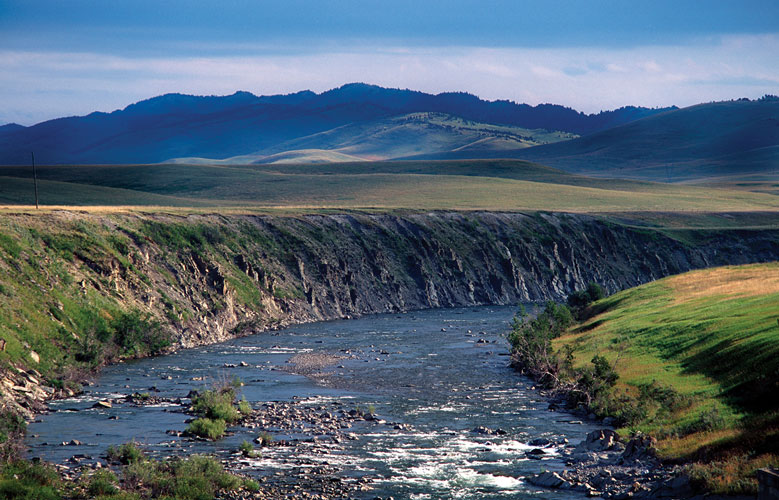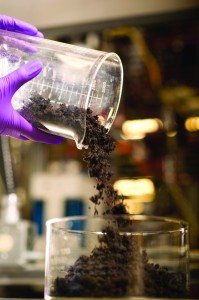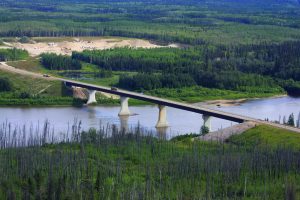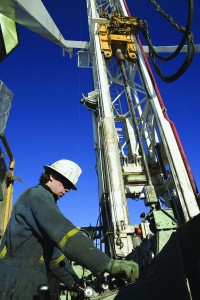Located in Western Canada, Alberta is a province rich with a beautiful environment, abundant natural resources and a strong economy. Albertans are no strangers to the power of innovation. Technological advancements have enabled us to access the world’s third-largest proven crude oil reserve, transforming our economy and making us a top global energy producer.
But thinking outside the box has done more than give us the technological ability to make these developments happen – it has also helped us develop them responsibly. Most Albertans believe that it is important for the world to transition to cleaner forms of energy. But global demand for energy continues to increase. Until alternative energy sources can meet this need, the world needs conventional energy producers that take their energy responsibilities seriously.
Alberta is committed to responsible energy production – because Albertans and Canadians expect nothing less. We want our province to excel at both oil and gas production and environmental stewardship.
And we recognize that conventional thinking and tools will not be sufficient to achieve this goal. The oil sands present unique environmental challenges. Innovation at each stage of the environmental management process has allowed Alberta to rise to these challenges – and it has made the oil sands a Canadian success story we can all be proud of.
Integrated Resource Management
Alberta’s rich history of environmental protection dates back more than four decades, to one of Canada’s first dedicated environment ministries. But when we began to develop the oil sands, we quickly grew to understand that the unique opportunity they presented was accompanied by unique challenges, and that conventional resource management – which often looks at different ecological goals in relative isolation – would not be sufficient to address them. Development of the oil sands requires what we call cumulative effects management – decision-making informed by comprehensive information about the consequences for our land, air, water, and biodiversity.
That’s why we’re pioneering a new approach to environmental stewardship in Alberta. This approach is called integrated resource management, and its premise is simple: our environmental policies need to reflect a single, unified set of clearly defined goals and the best information available. This is a bold new vision for the future – and we know we won’t achieve it by thinking and managing the same way we always have. So we’re pursuing new ways of doing things – starting from the very top and working down. This spring, under the mandate of Alberta Premier Alison Redford, our two environmental protection ministries – Alberta Environment and Water and Alberta Sustainable Resource Development – became a single department. This amalgamation has brought a sharper focus to issues surrounding the development of natural resources and on the environmental priorities that matter to Albertans. Our long-term policy frameworks, environmental monitoring innovations, and remediative measures all feature great examples of how integrated resource management has led to ongoing thinking outside the box.
Policy Frameworks and Long-term Planning
Environmental stewardship necessarily involves a certain amount of reactive decision-making. But we are changing that way of thinking. Industrial development, economic growth, and demographic shifts exert constantly evolving pressures on the environment, and our management of them must be just as flexible. But we can minimize the need for reactive decisions if we plan well for the future. That’s where our long-term policy frameworks come in. By thinking big, broad, and long-term, we ensure that our solutions for today won’t become the problems of tomorrow.
Alberta’s land-use planning frameworks
When we considered taking environmental policy ‘from the top,’ we came to an important realization – proactive environmental planning must start by determining what activities will take place in a given region. Our Lower Athabasca Regional Plan (LARP) kicks off a new era of land-use planning informed by this proactive approach. Based on independent advice and incorporating feedback from thousands of stakeholders and members of the public, it is a comprehensive land-use blueprint for the Lower Athabasca region, which is home to Alberta’s oil sands. The deposits are located in three major areas in northeast Alberta, underlying 140,200 square kilometres – or an area about the size of Florida, with the amount of land disturbed for mining roughly the size of the Kennedy Space Centre.
Land-use planning sets the groundwork for balancing the many different pressures put on Alberta’s environment. Its rules provide certainty to industry and set the stage for the diversification of Alberta’s economy; they also set aside dedicated areas for recreation and conservation. Under the LARP, total conserved land within this region of Alberta has increased to more than two million hectares. And environmental pressures are addressed head on, with new environmental management frameworks to protect air, groundwater, and surface water quality. Triggers are set to warn us when environmental impacts approach these limits, so that corrective action can be taken early on.
This approach to land-use planning embodies an important truth: each of our regions is unique, so we need to look beyond a one-size-fits-all provincial approach to protect Alberta’s ecological heritage. Eventually, a total of seven land-use plans will be in place, covering the entire province. Although each plan will address different challenges and opportunities, they will share a common purpose: to promote strong economic growth, vibrant communities, and ecological sustainability.
Managing our most important resource – water
Although Alberta is famous for oil and gas, we know there’s nothing more fundamental to life than access to a safe and secure water supply. Like any other resource, our fresh water is facing more competing pressures for use than ever before – and that means that our management of these pressures needs to be as responsive as possible. We’re accomplishing this through a number of different policy avenues that address every aspect of water use in Alberta. First, we’re improving our knowledge of groundwater availability in Alberta through a groundwater inventory program. We’re using cutting-edge airborne geophysical survey technologies to collect comprehensive information about groundwater in Alberta, and using this information to supplement the monitoring of 250 observation wells across the province. This information will help us to make the best possible decisions about water allocation going forward. But we can’t make those decisions using raw data alone – Alberta’s water belongs to Albertans, and their opinions must inform our policies. That’s why we’re launching Alberta’s Water Conversation in 2013. This consultation will be an opportunity for people across the province to share their feedback and concerns about water allocation with us; what we hear will inform future policy decisions. We know that many Albertans have important opinions on water management, but no forum in which to share them. The Water Conversation will create that forum.
In Alberta, we recognize that resource-based activities such as oil and gas developments rely on water for their day-to-day operations. That’s why the Government of Alberta, in partnership with the Canadian Federal Department of Fisheries and Oceans, has implemented a special water management framework for the Athabasca River that sets strict rules on when and how much water oil sands companies can withdraw to support operations. These limits are some of the most protective in the world: all existing and approved oil sands facilities withdraw less than one per cent of the river’s annual flow. Because the use of freshwater is limited, companies are forced to innovate in order to increase the use of other sources of water, like wastewater. In other words, innovations in policy lead to innovations in process – and that leads to benefits for everyone involved.
Management and Monitoring
Alberta’s Regulatory Enhancement Project
While we’ve been working hard to plan sustainably for the future, we also recognize the need to effectively manage and minimize the environmental impacts of development in the present. To do this, we need regulatory and monitoring mechanisms that are as robust and comprehensive as we can make them. And that’s exactly what we’ve set out to accomplish through Alberta’s Regulatory Enhancement Project (REP). REP is built on a simple but powerful premise: that regulatory efficiency is actually a win-win proposition for industry and the environment. Providing clear guidance and decisions to industry helps us to enforce the environmental standards that protect Alberta’s natural heritage – but it also makes us a better place to do business, enhancing Alberta’s competitiveness in the global energy market.
Approaching environmental management from this new perspective, it’s easy to see that enhancing regulatory efficiency is in the interests of all Albertans – and that’s why it’s the touchstone of our new Responsible Energy Development Act. The Act implements a number of innovative measures – but one of the most important is the creation of a single regulatory system for Alberta’s energy resources. Currently, energy resources in Alberta are regulated by two separate sources of authority, which necessarily results in a certain amount of inefficiency. A single regulator will be able to assess the entire lifecycle of an industrial project and all of its associated impacts – environmental and otherwise – and make the most informed policy decisions possible. This reflects the reality that the economic benefit and the environmental outcomes we expect from these developments are two sides of the same coin.
Gathering Information: Our Joint Monitoring Program
Extensive environmental monitoring has been taking place in Alberta’s oil sands region for more than four decades. The region has, for example, long been Alberta’s most heavily monitored for air quality. However, we recognize that the potential environmental impacts of oil sands development necessitate a monitoring program that is even more rigorous and comprehensive than what has been done in the past. We have partnered with the Canadian federal government to implement a bolstered monitoring system for the oil sands that will provide us with the comprehensive, timely information we need to detect changes in Alberta’s environment and manage the cumulative impacts of industrial development.
When the new program is fully implemented in 2015, it will enhance our monitoring capabilities in a number of ways. A greater range of tests, done at more sampling sites over a larger geographic area, will give us more information, updated more frequently. We’ll also incorporate the very latest scientific methodologies for both air and water testing, giving us the greatest possible confidence that the information we receive is accurate. And, we’ll use this information to create an integrated data management program that is accessible to the public and subject to external scientific peer review by some of the world’s finest scientists. The result of these innovations will be a comprehensive, integrated, credible monitoring system that is one of the most advanced of its kind in the world. This system will both help us to set more informed goals for environmental management, and hold government and industry accountable for meeting those goals.
Sharing Information: Our Oil Sands Information Portal
We’re implementing the most innovative, cutting-edge technologies not only to keep our monitoring comprehensive and rigorous, but to ensure that the information we collect is widely accessible. We know that if we want to be seen internationally as a world-leading responsible energy producer, it is our duty to be open and transparent in our reporting. In 2011, we launched Alberta’s Oil Sands Information Portal (OSIP) (http://environment.alberta.ca/apps/osip/), to ensure that a clear picture of the data we’re collecting on the environmental impacts of the oil sands is available to anyone who wants to see it. OSIP is a free-to-access, map-based website that includes comprehensive information about industry performance, water quality and use, climate change, reclamation, air, and biodiversity. Open access to this data allows people to form their own opinions and ask their own questions about oil sands industry performance and regulatory oversight. We know that good science is driven by informed debate and dialogue, and we want to encourage this – we have much to gain, and nothing to lose from doing so.
Addressing Environmental Impacts
The social licence we have as a government to develop Alberta’s resources comes with an expectation that we will minimize the environmental impacts of that development at each step of the way. It also comes with an expectation that we will address the impacts that do occur as effectively and efficiently as we can.
We recognize that industrial spills and releases are a source of concern not just for Albertans, but for neighboring jurisdictions – and we take a great deal of care to ensure that they do not occur. There are over 400,000 kilometres of pipeline in Alberta. Considering the size of our pipeline network, spills are a rare occurrence – and we’re currently undertaking a comprehensive pipeline safety review to ensure the integrity of this critical infrastructure. However, when an incident does occur, we have well-developed procedures, lines of communication, and a dedicated team – the Alberta Environment Support and Emergency Response Team (ASERT) – ready to ensure that containment, clean-up, and environmental impact assessments take place as efficiently as possible and according to rigorous standards. Under Alberta law, it is the polluter – not the Alberta taxpayer – who pays for these remedial measures. But just because we don’t foot the bill doesn’t mean we’re not constantly working on ways to make our emergency response measures more effective. For example, ASERT currently operates an innovative program that provides communities with the training they need to use and deploy spill response units. The Community Spill Response Program currently operates in six communities throughout Alberta, helping to ensure that those who are first impacted by a spill are empowered to assist first responders.
Emissions mitigation and our climate change policy
Alberta recognizes that we have a responsibility to address the impact that all of our province’s activities have on climate change. To do so, we’ve developed innovative environmental policies and programs, including the first mandatory greenhouse gas emissions reduction program in North America that applies to all large industry. To meet reduction targets, facilities can either make physical reductions, purchase Alberta offsets, or pay $15 per tonne into our Climate Change Emissions Management Fund, which funds clean technology and adaptation projects. In the last five years alone, this program has resulted in the reduction of approximately 32 million tonnes of greenhouse gas emissions, and the accumulation of more than $312 million to fund future innovations.
While it is important that we compel industry to action, this is only one way to address climate change – and we know that our approach must be comprehensive in order to be responsible. That’s why we launched an innovative Climate Change Strategy in 2008, with the goal of knocking 50 million tonnes off our ‘business as usual’ emissions levels by 2020. To help kick-start a key component of this strategy, we’ve committed $1.55 billion in funding for three large-scale carbon capture and storage projects, slated to reduce 4.1 million tonnes of greenhouse gas emissions per year. In addition, we’ve committed $2 billion to supporting mass transit projects through our Green Transit Incentives Program (GreenTRIP). And, recognizing the important role consumers play in reducing greenhouse gas emissions, we’ve invested millions of dollars helping homeowners and businesses upgrade to more energy-efficient options for everything from appliances to commercial light trucks.
Conclusion
Thinking outside the box has allowed Alberta to develop the oil sands in a responsible way – one that effectively addresses the environmental challenges they present. We are proud of what we’ve accomplished so far, and we’re not finished yet. As challenges arise, we will meet them. As opportunities to improve on what we do well are presented, we’ll embrace them. We know that the world is watching, and we are ready. We will continue to innovate, and we will continue to set an example of sustainable, responsible resource management that all Canadians can be proud of.
For more information, please visit: www.gov.ab.ca






































